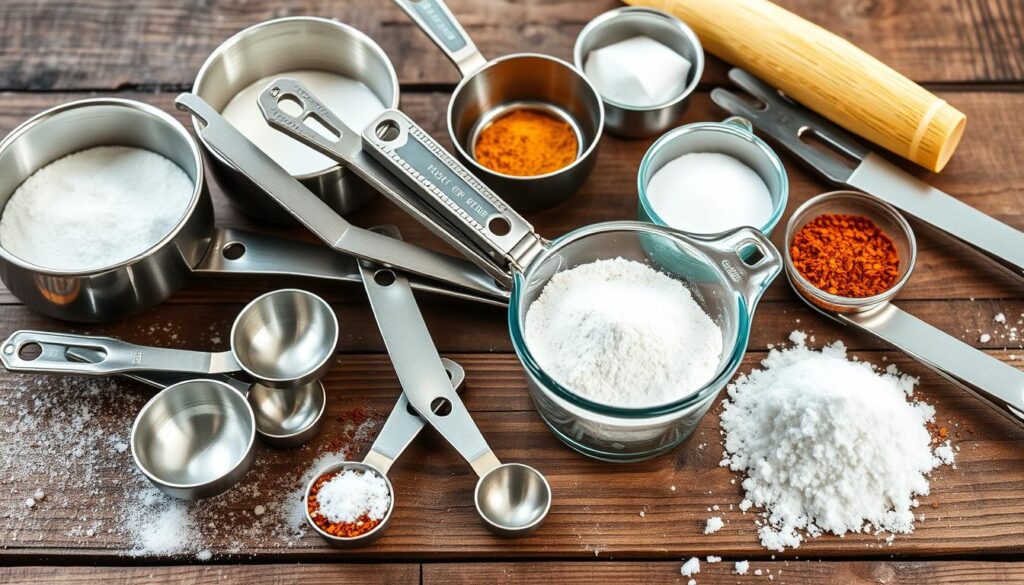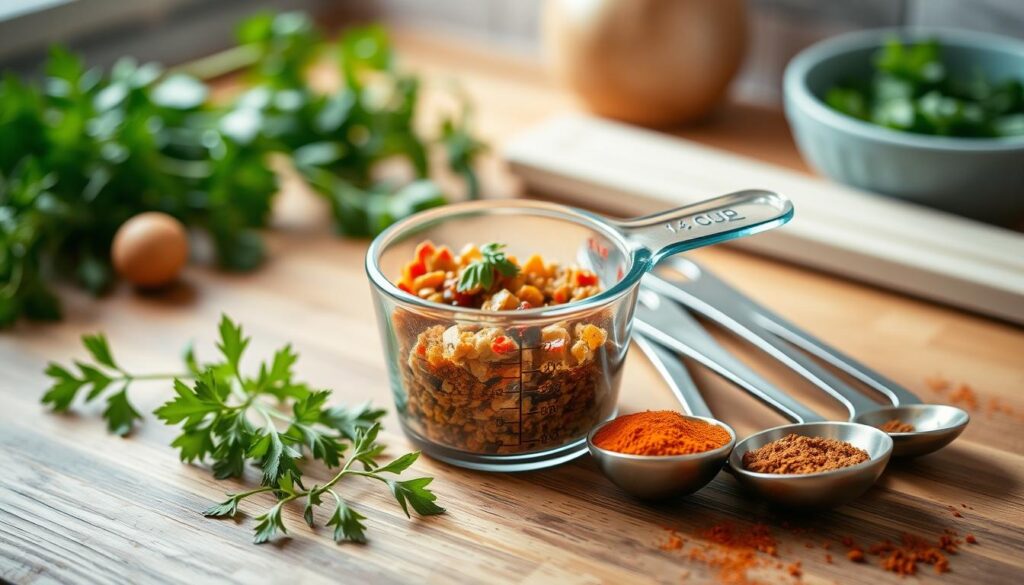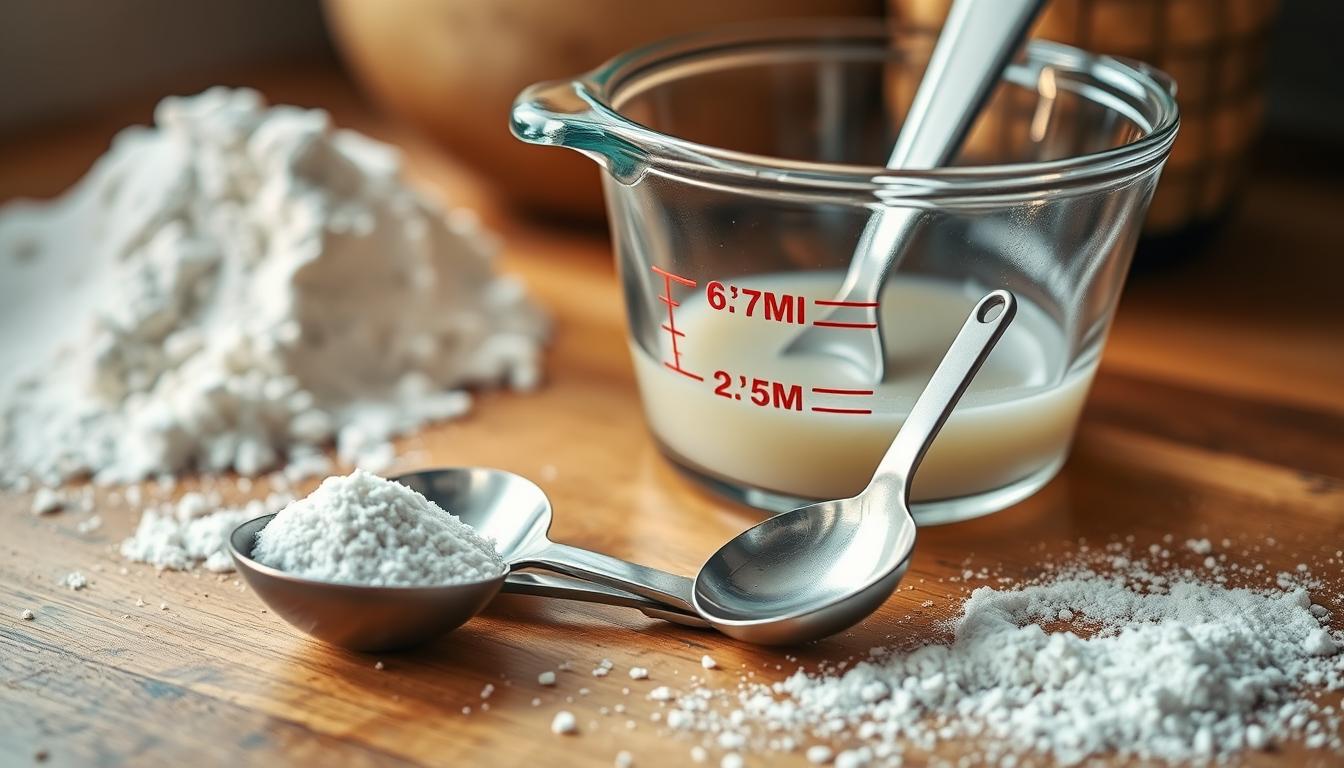In cooking and baking, getting the right measurements is key. Many wonder: How many tablespoons are in 1/4 cup? Knowing this helps you follow recipes well and get great results.
Whether making a meal, dessert, or snack, knowing how to convert cups to tablespoons is vital. This article will answer your question, highlight the importance of exact measurements, and give tips on mastering kitchen conversions.
Key Takeaways
- 1/4 cup equals 4 tablespoons
- Accurate measurements are crucial for consistent cooking and baking results
- Understanding the difference between dry and liquid ingredient measurements is important
- Proper measuring tools, such as a set of measuring cups and spoons, can help ensure accurate measurements
- Mastering kitchen measurement conversions can enhance your cooking and baking skills
Understanding Cooking and Baking Measurements
Getting the measurements right is key in cooking and baking. Whether it’s a tasty dessert or a hearty main dish, small mistakes can change everything. Knowing how to measure accurately is vital for any chef or baker.
The Importance of Accurate Measurements in Cooking and Baking
Measurements are crucial for a dish’s success. In baking, the exact mix of dry ingredients is needed for the right texture and rise. In cooking, the right amount of liquid can make a sauce flavorful or weak.
Common Measurement Units in Recipes
Recipes use many measurement units like cups, tablespoons, and teaspoons. Knowing how to convert these units is essential for following a recipe well. Learning about these units can make you a better cook.
| Measurement Unit | Equivalent |
|---|---|
| 1 cup | 16 tablespoons |
| 1 tablespoon | 3 teaspoons |
| 1/4 cup | 4 tablespoons |
| 1/2 cup | 8 tablespoons |
| 3/4 cup | 12 tablespoons |

“Precise measurements are the foundation of any successful recipe. Mastering the art of accurately measuring ingredients is the key to consistently delicious results in the kitchen.”
Cups and Tablespoons: A Conversion Guide
Learning to convert cups to tablespoons is key for cooks and bakers. It helps when adjusting recipes or making dishes you love. Knowing how to switch between these measurements is crucial.
The standard measurement for a cup is 16 tablespoons. But, the exact amount can change based on the recipe or ingredient. Mastering these conversions ensures your dishes taste just right.
Navigating Conversion Challenges
Converting fractions is a big challenge with cups and tablespoons. Recipes often use fractions like 1/4 or 3/4 cup. But, there are simple ways to make these conversions easy.
| Cup Measurement | Tablespoon Equivalent |
|---|---|
| 1/4 cup | 4 tablespoons |
| 1/3 cup | 5 tablespoons + 1 teaspoon |
| 1/2 cup | 8 tablespoons |
| 2/3 cup | 10 tablespoons + 2 teaspoons |
| 3/4 cup | 12 tablespoons |
| 1 cup | 16 tablespoons |
Understanding these conversions lets you easily adjust recipes. You can make more or less of a dish as needed.
“Accurate measurements are the foundation of successful cooking and baking. Mastering the relationship between cups and tablespoons is a game-changer in the kitchen.”

Getting good at converting cups to tablespoons lets you control your cooking. It makes every dish or baked good a success.
How Many Tablespoons in 1/4 Cup?
When cooking and baking, getting the measurements right is key. Many wonder: how many tablespoons are in 1/4 cup? The answer is simple, but it can change a bit based on how you measure.
The Simple Answer
Generally, 1/4 cup equals 4 tablespoons. This is a common rule in recipes. But, the exact count can change based on the ingredient and how you measure it.
Variations in Measuring Techniques
Measuring how many tablespoons in 1/4 cup can depend on how you scoop and level the ingredients. For example, scooping gently and leveling with a knife might give a different count than packing the ingredient tightly. These small differences can affect the final count.
Also, the ingredient’s density and texture can influence the count. Dry ingredients like flour or powdered sugar might have a different count than denser items like brown sugar or shredded cheese.
| Ingredient | Tablespoons in 1/4 Cup |
|---|---|
| Flour | 4-5 tablespoons |
| Brown Sugar | 3-4 tablespoons |
| Granulated Sugar | 4 tablespoons |
| Shredded Cheese | 3-4 tablespoons |
The exact number of tablespoons in 1/4 cup can vary. It depends on the ingredient and how you measure. Always follow recipe instructions and use the right tools for the best results.
Dry vs. Liquid Ingredient Measurements
Getting the right amounts of ingredients is key in cooking and baking. But, dry and liquid ingredients need different measuring methods. Knowing these differences is vital for great results.
Measuring Dry Ingredients
For dry ingredients like flour, sugar, or spices, the right tools and methods are important. Use cups or spoons to measure by volume, not weight. Here are some tips for accurate measurements:
- Use a dry measuring cup and level off the ingredient with a flat knife or spatula.
- Lightly spoon the dry ingredient into the measuring cup, rather than scooping or packing it down.
- For powdery ingredients like flour or cocoa powder, gently stir or sift the ingredient before measuring to aerate it and prevent packing.
- When measuring small amounts, use standard measuring spoons, not regular tableware.
Accurate dry ingredient measurements are crucial in baking. The right mix of flour, sugar, and other dry ingredients affects the texture and structure of baked goods.
| Dry Ingredient | Equivalent Measurements |
|---|---|
| All-Purpose Flour | 1 cup = 120 grams |
| Granulated Sugar | 1 cup = 200 grams |
| Brown Sugar | 1 cup = 220 grams |
| Cocoa Powder | 1 cup = 100 grams |
Remember, how you measure dry ingredients greatly affects your recipes. Always use the right techniques and tools.
Cup to Tablespoon Conversion for Other Fractions
Converting 1/4 cup to tablespoons is key, but it’s not the only one. Knowing how to change 1/2 cup and 3/4 cup to tablespoons is also crucial. This helps when you need to adjust the amount of ingredients in recipes.
Let’s look at the conversions for some common fractions:
- 1/2 cup: Equals 8 tablespoons
- 3/4 cup: Equals 12 tablespoons
- 1 cup: Equals 16 tablespoons
Remembering these conversions makes scaling recipes easier. It helps you get the right amount of ingredients for great results. Whether you’re dealing with cup to tablespoon conversion, fraction to tablespoon, or other cooking measurements, baking measurements, recipe measurements, or kitchen measurements, knowing these relationships is key.
“Precise measurements are the foundation of great cooking and baking. Mastering cup to tablespoon conversions is a valuable skill that will serve you well in the kitchen.”
By learning these cup to tablespoon conversion ratios, you’ll be ready to adjust recipes. This ensures your dishes come out just right. Whether you’re measuring dry or liquid ingredients, knowing your cooking measurements and baking measurements will help you succeed.
Tips for Accurate Measuring
Getting precise measurements is key in the kitchen, for both cooking and baking. The right tools and techniques help make sure your recipes come out right. Here are some tips to help you get better at measuring accurately.
Utilizing Proper Measuring Tools
The secret to exact kitchen measurements is using the right tools. Here’s what you should know:
- Get a good set of measuring cups and measuring spoons that are clear and accurate.
- For dry ingredients like flour or sugar, use the “dip and sweep” method. This means dipping the cup or spoon, then leveling it off with a straight edge.
- For liquid ingredients, use a clear glass or plastic measuring cup. Make sure to read the measurements at eye level for an accurate pour.
- Don’t use regular spoons or cups from your drawer. They can cause inconsistent recipe measurements.
By getting the right kitchen measurement tools and using the right methods, you’ll get perfect results in the kitchen.
The Importance of Precise Measurements in Baking
Baking is a science that needs cooking measurements, baking measurements, recipe measurements, and kitchen measurements to be exact. Getting the ingredients right is key to making great baked goods. This includes everything from light cakes and cookies to thick breads and flaky pastries.
Even tiny mistakes in measuring can change how a baked item turns out. Too much flour makes it dense and dry. Too much sugar can make it too brown or feel gritty. Getting the measurements right helps baking work as it should, leading to the perfect result.
- Accurate measurements keep the right mix of wet and dry ingredients. This ensures baked goods have the right rise, texture, and taste.
- Getting the right amount of leavening agents like baking soda and baking powder is key. They help baked goods rise and have the right structure.
- Measuring fats like butter or oil precisely is important. It helps baked items be rich, tender, and have the right feel in your mouth.
Baking is a precise art. Learning to measure accurately is essential for any baker or home cook who wants to make perfect baked goods every time.
“Baking is like chemistry, and you have to follow the recipe exactly.”
– Duff Goldman, American chef and television personality
Cooking Measurements: Flexibility and Adjustments
While precise cooking measurements are key for baking success, cooking offers more room for flexibility. Skilled cooks can tweak ingredient quantities and measurements to match their taste and achieve the perfect flavors.
Cooking is more about creativity than following exact recipe measurements. Unlike baking, where exactness is crucial, cooking lets you play with kitchen measurements. You can adjust recipes based on your taste, dietary needs, or what ingredients you have.
For example, a dish might need a certain amount of salt, but you can adjust it to your liking. Or, in a stir-fry, you can change the vegetable amounts to fit your taste or dietary needs.
“Cooking is an art, and cooking measurements are just one tool in the artist’s palette. The flexibility to adjust recipe measurements is what allows cooks to truly make a dish their own.”
Knowing basic cooking measurements is important, but cooking also values creativity and personal touch. By being flexible, cooks can improve their dishes’ flavors and textures. This way, they create unique and enjoyable meals.
Mastering Kitchen Measurement Conversions
Home cooks and bakers can find many online tools and charts to help with kitchen measurement conversions. Learning these conversions is key to easily changing recipes and getting consistent results.
Online Conversion Tools and Charts
Just a quick online search can lead to many helpful conversion tools and detailed measurement charts. These resources give users fast access to accurate measurements. They can convert cups to tablespoons, fractions to tablespoons, and more.
By using these digital tools, home cooks and bakers can improve their skills in the kitchen. With a few clicks, they can find the right tablespoon measurements for any recipe. This makes cooking and baking easier and more enjoyable.
